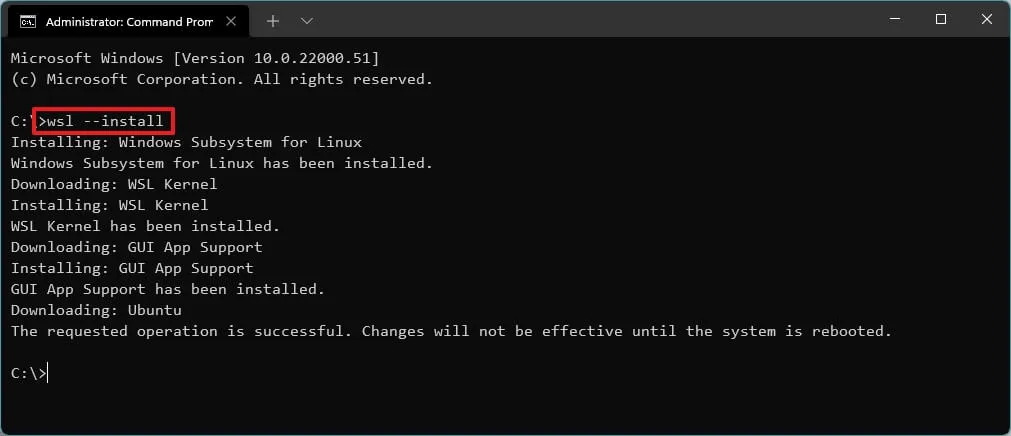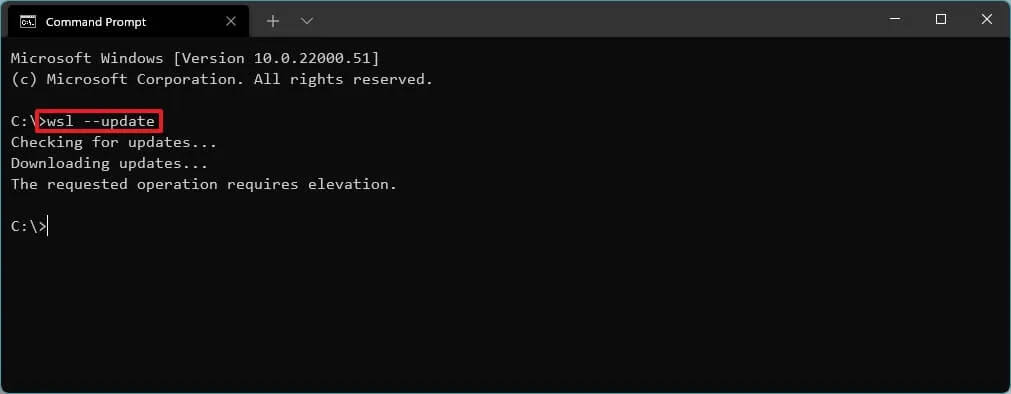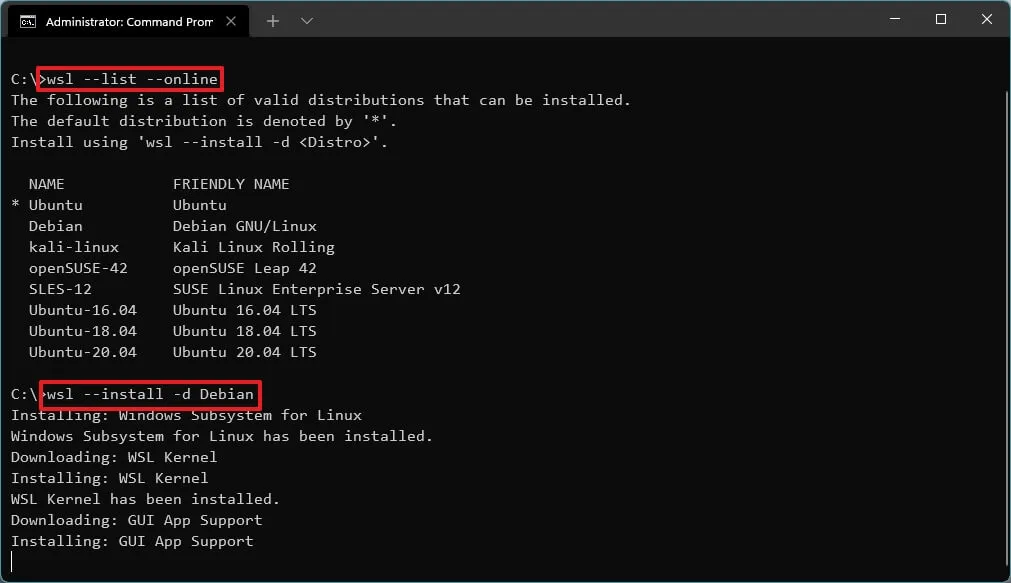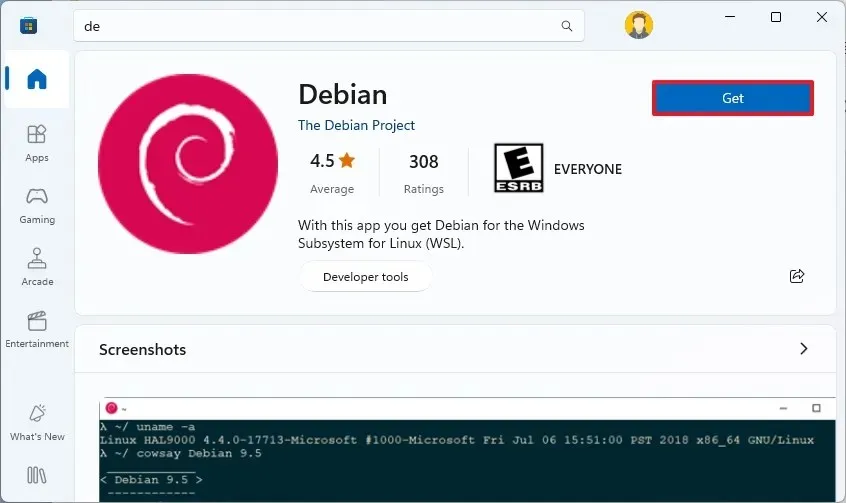Step-by-Step Guide to Install Windows Subsystem for Linux (WSL) on Windows 11

- To install WSL on Windows 11, open PowerShell or Command Prompt (admin), run the “wsl –install” command, and restart the computer to set up the Windows Subsystem for Linux alongside the Ubuntu Linux distribution.
- To install WSL with a specific distro, run the “wsl –install -d DISTRO-NAME” command.
- To install WSL from the Microsoft Store, enable the “Virtual Machine Platform” feature and then download the WSL app from the Store.
On Windows 11, Microsoft simplifies the installation of the Windows Subsystem for Linux (WSL) to a single command that downloads and installs all necessary components, including the virtual machine platform and support for Linux GUI applications. In this guide, you’ll learn how to complete this process easily.
This command also installs the latest Ubuntu distribution by default. If you prefer a different Linux distribution, you can specify that in the command. You can also update the WSL kernel more conveniently through the command line. Alternatively, you can install WSL via the download available from the Microsoft Store.
What is WSL on Windows 11?
The Windows Subsystem for Linux is an optional feature that allows users to run various distributions of Linux on Windows 11 (and 10) without requiring a separate machine, dual-boot setups, or virtual machines. After installing WSL, it creates a virtualization layer using the Microsoft Hyper-V hypervisor, enabling you to run Linux distros like Ubuntu, Debian, or Fedora natively on your device.
This Linux subsystem provides a fully functional environment, including the Linux kernel, system calls, and libraries, allowing you to run applications as if they were on a native Linux system.
Microsoft integrates WSL with Windows, enabling direct access to files and apps from the Linux environment. Additionally, you can access the distros files straight from File Explorer without extra configuration.
While WSL is primarily used for command-line applications, it also supports the installation and running of GUI (Graphical User Interface) applications through tools like X11 or Wayland.
This guide will provide you with straightforward steps to install the WSL platform on your computer and details on how to update the Linux kernel on Windows 11.
Install WSL on Windows 11
To install WSL on Windows 11 using Command Prompt (or PowerShell), follow these steps:
-
Open Start on Windows 11.
-
Search for Command Prompt (or PowerShell), right-click the top result, and select the Run as administrator option.
-
Type the following command to install WSL on Windows 11 and press Enter:
wsl --install

-
Restart your computer to complete the WSL installation on Windows 11.
-
Follow the setup for the Linux distribution as needed.
After completing these steps, the required Linux components will automatically install on Windows 11, including the latest version of the Ubuntu Linux distribution.
In some cases, the install command may encounter issues, depending on your Windows setup. If you receive the error code 14107, check the error message to identify which components could not be enabled, such as the “Virtual Machine Platform.” If needed, go to Settings > Optional features > More Windows features, enable the “Virtual Machine Platform,” and click “OK” to add the components. You can then run the WSL install command again.
Update WSL Kernel
To update the WSL kernel from Command Prompt on Windows 11, follow these steps:
-
Open Start.
-
Search for Command Prompt (or PowerShell), right-click the top result, and select the Run as administrator option.
-
Type the following command to update the WSL kernel and press Enter:
wsl --update

After completing these steps, if an update is available, it will download and install on your computer.
Install WSL with a Specific Distro on Windows 11
To install WSL with a specific Linux distribution on Windows 11, use these steps:
-
Open Start.
-
Search for Command Prompt, right-click the top result, and select the Run as administrator option.
-
Type the following command to see a list of available WSL distributions you can install and press Enter:
wsl --list --onlineQuick note: You can install Ubuntu, Debian, Kali Linux, openSUSE, Oracle Linux, and SUSE Linux Enterprise Server. -
Type the following command to install WSL with a specific distro on Windows 11 and press Enter:
wsl --install -d DISTRO-NAME

Make sure to replace “DISTRO-NAME” with the name of the desired distro, such as Debian.
-
Restart your computer to finalize the WSL installation on Windows 11.
-
Proceed with the Linux distribution setup as needed.
Once you complete the steps, the Windows Subsystem for Linux components will be installed along with your selected Linux distribution.
Install WSL from the Microsoft Store
If you wish to install WSL and different distributions from the Microsoft Store, you first need to enable the required components from the “Windows Features” interface and then download WSL from the Store.
1. Enable WSL Required Components
To install the necessary components to run Linux on Windows 11, follow these steps:
-
Open Start.
-
Search for Turn Windows Features on or off and click the top result to open the app.
-
Check the “Virtual Machine Platform” option.

-
Check the “Windows Subsystem for Linux” option.
-
Click the OK button.
-
Click the Restart button.
After completing these steps, you can proceed to download the app from the Microsoft Store.
While the Microsoft Store method should enable and install all the necessary components, you may still need to manually enable the “Virtual Machine Platform” and “Windows Subsystem for Linux” modules to prevent encountering errors such as error code 14107 or 0x8004032d.
2. Install Windows Subsystem for Linux App
To install the WSL layer on Windows 11, please follow these steps:
-
Click the Install button.
-
Click the “Open Microsoft Store” button (if applicable).
-
Click the Install button again.

3. Install Linux Distro
To install a Linux distribution from the Microsoft Store, follow these steps:
-
Open the Microsoft Store app.
-
Search for Linux distributions, such as Debian.
-
Click the Get button.

-
Click the Open button.
Upon completing these steps, WSL will be successfully installed on Windows 11, providing support for Linux GUI apps and the chosen Linux distribution.
Update September 12, 2024: This guide has been revised for accuracy and to reflect the latest process changes.


Leave a Reply